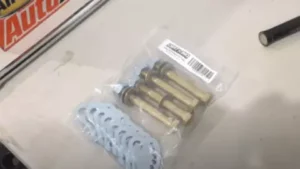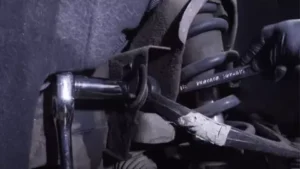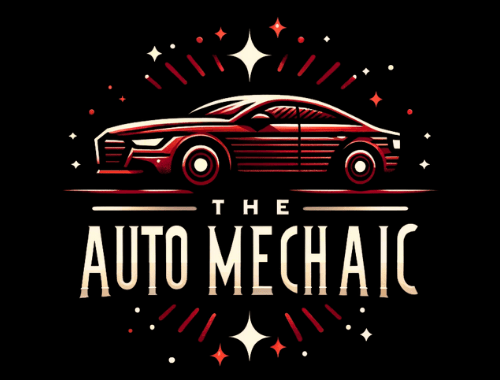Before getting behind the wheels of your beloved Chevy Truck, you need to set plenty of things right, like how to adjust the camber on a Chevy truck.
I am sure you want an easy ride; you don’t want to bungle or spill the content of the load you carry on your trunk while doing the corners. You certainly want a smooth ride without fighting your steering wheel through every mile of driving.
It would help if you had plenty of ground clearance and a lot of alignments. Here is how to adjust the camber on a Chevy truck for a smooth, even ride.
What is a Camber?

The camber is the outward or inward inclination of the front wheels measured against the wheel’s vertical axis.
The camber plays a critical role when maneuvering corners. If it is not aligned correctly, it can cause handling issues, excessive tire wear, and fuel consumption that unnecessarily drains your pockets.
The critical indicators for a deviation from the correct alignment are increased gas mileage and tire wear, and, of course, you will notice significant steering wheel handling issues. You should always check your camber alignment to ensure it aligns with the manufacturer’s default settings.
Wheel alignment is crucial for safe driving. Experts recommend checking your camber setting to ensure the wheels are correctly aligned.
Various types of Chevy Truck Camber?
Traditionally, all manufacturers set a specific camber alignment for every vehicle they produce. The alignments ensure a lot of tire thread contacts the asphalt, enabling good traction. The opposite is true when one side of the tire has all its weight resting vertically against it.
Chevy Trucks come with three camber types: positive, negative, and zero camber. When the top of the wheel is tilted inwards, we have a positive deviation from the vertical axis, referred to as positive camber. We have a negative camber when the upper part of the tire is inclined inwards, creating a negative deviation from the vertical axis.
Lastly, we gave a Zero camber when the tire is vertically straight with no tilting or leaning. You can always change the alignment to suit your needs; to do so, you must master how to Adjust Camber on a Chevy Truck.
For what reasons Do You Need to Adjust the Camber on Chevy Trucks?
While most manufacturers recommend a particular wheel alignment or camber adjustment, the Chevy truck allows you to choose the one that suits your needs from the three available: neutral, positive, and negative camber adjustment.
Terrain and nature of the road: Imagine residing in a comparatively flat locality. Most of your rides will be on straight roads with little corners to meander. Now imagine living in a hilly place. The meandering increases a simple mile covered, and one will have made several corners compared to residing in a relatively flat area.
Safe driving: The Chevy truck offers three alignment options. For instance, setting the camber alignment to negative works better for flat roads with little corners and meandering, but negative is the most suitable and safest alignment for hilly and sloppy mountainous driving.
Finding the Best Camber Angle on a Chevy Truck
Different camber alignments are designed for different driving needs, so the best camber angle on the Chevy truck solely depends on your needs, tests, and preferences.
For instance, the neutral or zero cumber allows excellent braking and traction if you drive on straight roads. Additionally, the alignment causes more evenly distributed tire wear than the one-sided tire in negative and positive alignments.
Conversely, neutral alignment can present many challenges when pursuing corners and meanders. Positive camber alignment works best if you use the truck as an agricultural vehicle.
The negative camber alignment works best for corners and meanders. It is ideal for curvy roads with lots of corners. Interestingly, some Chevy trucks come with a hybrid camber, which allows you to try both the negative and positive camber alignments.
Camber angle influences performance and tire durability. We recommend changing the alignment depending on the need, that is, the purpose and the nature of the roads you drive on.
Materials needed to adjust the camber
How do I adjust Camber on a Chevy Truck? What do I need? Aligning your camber to your preferred settings is relatively straightforward with the right tools and equipment. Here is the material needed to adjust the camber on your Chevy truck.
- This tool is handy because you need a Wrench Set to fasten and unfasten.
- You need a socket set, which is handy when taking off and fastening bolts and nuts.
- You need an Alignment Machine – of course, you will need an alignment machine to help you do the alignment properly.
- Lastly, it would help if you had an impact gun.
Step-by-step guide for How to adjust camber on Chevy Truck

Chevy trucks are DIY-friendly thanks to their purpose-built products that allow for adjustability. But while you can change the camber on your Chevy truck all alone, it can be challenging if you have never done it before. Here is a guide to help you get things done.
Step one: Set up your garage and car
First, before anything, you need to ensure everything is in its rightful place and that you have everything needed. Besides assembling the necessary tools, you need to set up your car and garage. Make sure that your car is loaded and seats on level ground. If some garages are perfectly leveled, you can fabricate one using wooden planks and a laser leveling gauge if it isn’t—more on this in the following article.
Step two: Measure the existing cumber
It’s time to start once your truck is set on level ground. Remember to take all precautionary safety measures. The most basic one is to lock both your parking and main brakes. Next, you need to establish the current camber situation, determine a cambered alignment, and act accordingly. Please take out the inclinometer and measure your Chevy truck’s camber alignment as it stands right now.
To do so, you need to ensure your truck tires are pointed straight. Regulate the wheel pressure to the truck producer’s provisions. Have you forgotten the specifications? You can find them easily on your user manual or the tire placard usually mounted on the driver’s side door.
After adjusting the pressure, attach the camber gauge to the wheel or spindle, depending on the user’s instructions. Next, turn the gauge until the bubble shows that it is level. The caliper’s central component should align perfectly with the center of the hub. For more details, check the video.
You need to get everything correct at this stage because any crooked readings will screw measurements and hinder the results. So, the tire should all be straight, and the camber reading must align perfectly.
Step three: Remove the tires
Next, we will work on the front wheel control arms. At the bare minimum, you need a wrench-set car jack; these two are necessary. Additionally, you might need gloves to protect your hands and a mat to kneel on. Start by loosening the hub cap if your truck wheels have a cover. Use a flat tip to pry, unfasten the cover, and remove it.
Security tip: Secure the chassis with the jack stands and choke the rear wheels.
Using the jack to rift the truck off the ground, jack the vehicle at the appropriate jacking point. Now that the truck is safe and above the ground, you can remove the tire. Start by unscrewing the lug nuts and placing them in a secure location. Once the nuts are out, detach the tire to expose the control arms.
Step four: Next, go for the arm mounting bolts
The camber mounting bolt helps you adjust the camber reading for your truck. Besides adjusting, they restore vehicle wheel alignment after suspension components are damaged or bent. So, how do you locate the bolts? Survey the control arm for the mounting bolts. They are located on the knuckle clevises on both sides of the frame.
After finding the mounting bolts, look for the camber alignment pins. They are usually an elongation of the frame. The camber alignment pin alongside the arm control bolts will help you adjust the camber to your preferences.
Step five: Loosen the upper control arm
Unlike in other vehicles where camber alignment is done by inserting shims in the control arm, the Chevy truck camber alignment is done via offsetting mounting bolts on the upper control arm. To do this, unfasten the non-camber mounting bolts on the upper control arm.
To do this, you require a wrench and sockets. Turn the bolts anti-clockwise while keeping an eye on the alignment pin. You can use an inclinometer and continue loosening the bolts until a favorable angle alignment slope is achieved to get the proper adjustment. After you have the required adjustment, fasten the bolts. Do not over-loosen or over-tighten them.
Step six: mounting back the tire
After adjusting, it’s time to return the tire to its position and lower the truck. At this stage, you may need a second person to help you ensure everything moves smoothly. Remove the jack and lower the chevy slowly. If you used an inclinometer to do the alignment, the result would be ok, but if you are not satisfied, you can always start the process again to your satisfaction.
Also Read: How To Remove A Leaf Spring In A Chevy Silverado
Camber on Chevy truck replacement cost
In most cases, camber alignment is a do-it-yourself home job, but if you want the services of professional mechanics, it will cost you around $30 to $50 per wheel. So, I will pay a total of $120 – 200 for the whole truck.
Sometimes, you may try to align the camber, but in vain. Your camber is most probably worn out and needs replacement. The cost for camber replacement varies from one vendor to the other, but typically, it ranges from $63- $70.
FAQs on How to Adjust Camber on Chevy Truck
01. What is the default camber alignment for the Chevy truck?
Like most manufacturers, the Chevy truck has a slightly positive camber alignment as its default setting. That means the wheel leans a little bit at the top. To change this setting, review our step-by-step instructions for Adjusting the camber on the Chevy Truck above.
02. What is the best camber alignment for high-speed driving?
You should align your Chevy truck camber alignment to negative for high-speed driving. Negative camber alignment allows the driver to control power more when the vehicle is at high speed, which will be impossible when doing neutral or positive alignments.
03. What are the problems or challenges caused by opposing camber alignment?
While negative camber has its positives, it also has its negatives. One negative effect is that it is almost guaranteed to run through your tires quickly, especially on a rough road. Other negative effects include a higher risk of the wheels breaking loose and the potential locking of your steering wheel.
04. What are the positive effects of positive camber alignment?
Positive camber alignment increases steering wheel handling abilities and provides excellent stability, which is good for off-road driving or using the truck for agricultural purposes.
However, it is troublesome, especially when making turns in corners. Disproportionate positive camber alignment is also known to cause abrasion or extreme tire wear on the outer part of the wheel.
Our verdict
While truck repairs and servicing largely remain a preserve for trained mechanics, the sole responsibility for servicing your Chevy truck lies with you. So, you might find camber, caster, or toe quite intimidating, but it helps you get acquainted with these terms. This guide focused on how to adjust the camber on a Chevy truck.
So far, we have discussed the different types of camber alignments and how to adjust them, including the challenges caused by excessive positive and negative ones. The guide is suitable for starters and nonstarters, but always leave it for a trained mechanic if you face a challenge adjusting your camber.

Bruce William is a professional content writer and vehicle engineer with extensive car maintenance and repair knowledge. His expertise spans all vehicle parts, offering practical solutions for various automotive issues. Bruce provides valuable insights through his website articles to help readers maintain their cars for optimal performance and longevity.
